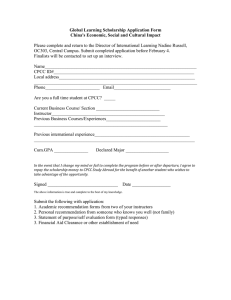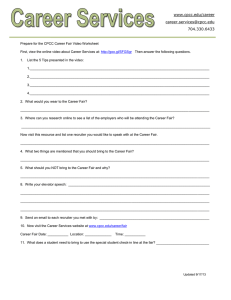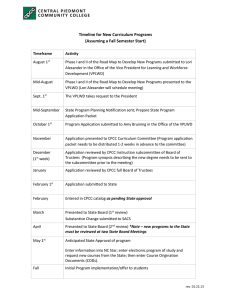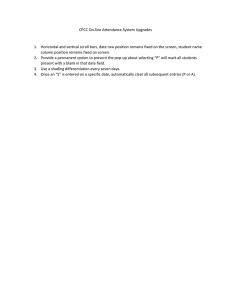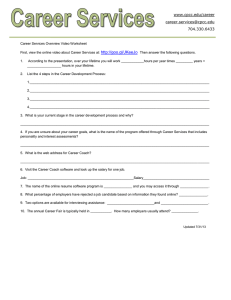Learning Unit Strategic Program Plan for Completion
advertisement
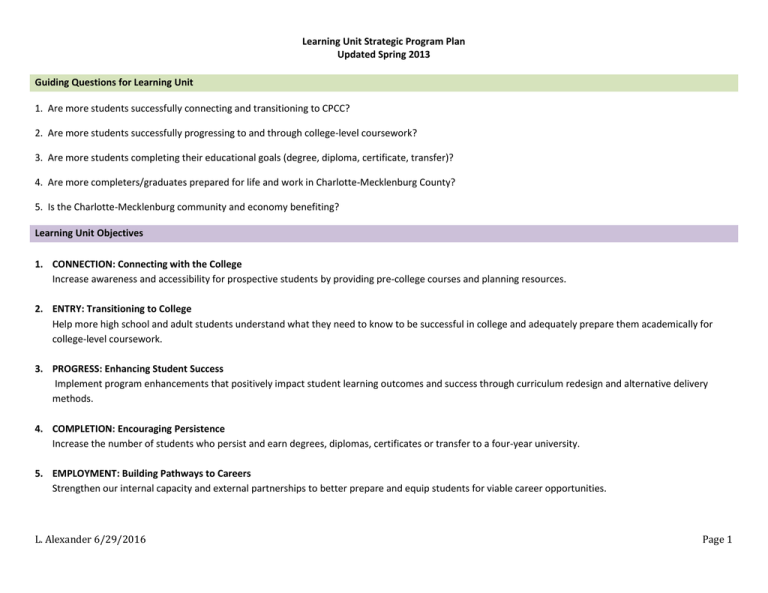
Learning Unit Strategic Program Plan Updated Spring 2013 Guiding Questions for Learning Unit 1. Are more students successfully connecting and transitioning to CPCC? 2. Are more students successfully progressing to and through college-level coursework? 3. Are more students completing their educational goals (degree, diploma, certificate, transfer)? 4. Are more completers/graduates prepared for life and work in Charlotte-Mecklenburg County? 5. Is the Charlotte-Mecklenburg community and economy benefiting? Learning Unit Objectives 1. CONNECTION: Connecting with the College Increase awareness and accessibility for prospective students by providing pre-college courses and planning resources. 2. ENTRY: Transitioning to College Help more high school and adult students understand what they need to know to be successful in college and adequately prepare them academically for college-level coursework. 3. PROGRESS: Enhancing Student Success Implement program enhancements that positively impact student learning outcomes and success through curriculum redesign and alternative delivery methods. 4. COMPLETION: Encouraging Persistence Increase the number of students who persist and earn degrees, diplomas, certificates or transfer to a four-year university. 5. EMPLOYMENT: Building Pathways to Careers Strengthen our internal capacity and external partnerships to better prepare and equip students for viable career opportunities. L. Alexander 6/29/2016 Page 1 Learning Unit Strategic Program Plan Updated Spring 2013 TION CONNECTION ENTRY PROGRESS COMPLETION OBJECTIVE #1 CONNECTION: Connecting with the College Increase awareness and accessibility for prospective students by providing pre-college courses and planning resources. CPCC Goals/ Key Strategies/Initiatives LRP Priorities Goal 1: Student Collaborations with CMS: Learning and Success 1. Career and College Promise Initiatives Career and College Promise provides dual enrollment opportunities for eligible North Carolina Goal 3: high school students for certificates, diplomas, and associate degrees that lead to college Community transfer or provide entry-level job skills. Catalyst Credit pathways options: 1) Career and Technical Education (CTE) – CPCC is currently offering 20 Career and Technical LRP Priorities: Pathways. Various Campus Land Acquisitions 2) College Transfer Pathway (CTP) – CPCC is currently offering Four Core 44 Transfer Pathways. and Expansions for Technical 3) Cooperative Innovative High School Programs – CPCC is currently offering three Cooperative Programs and Innovative High Schools with two more starting fall 2013. Gen. Ed Classrooms Results for 2012-2013: 764 students dually enrolled (non-duplicated headcount) 7444 credit hours registered L. Alexander 6/29/2016 EMPLOYMENT Accountability Measure/LRP NCCCS #3: First Year Progression and #6 Curriculum Completion CPCC KPI #3E: Percent of CMS graduates who enroll in CPCC AACC #1: Increase Completion Rates CBD #7: Increase proportion of credential completers Page 2 Learning Unit Strategic Program Plan Updated Spring 2013 OBJECTIVE #1 CONNECTION: Connecting with the College Increase awareness and accessibility for prospective students by providing pre-college courses and planning resources. CPCC Goals/ Key Strategies/Initiatives LRP Priorities Goal 1: Student 2. Expansion of Middle Colleges Learning and Success The state limits the number of seats per grade to 100 students and there is a waiting list for the Cato Middle College. A Levine Middle College High School would offer juniors and seniors in Goal 4: Mecklenburg County the opportunity to complete their CMS requirements at CPCC’s Levine Organizational Campus and their CPCC college credits at any of the college’s six campuses. Capacity to Serve LRP Priorities #2: Cato Land Acquisition and #10 Levine Campus Phase 3 Goal 1: Student Learning and Success Accountability Measure/LRP NCCCS #3: First Year Progression and #6 Curriculum Completion CPCC KPI #3E: Percent of CMS graduates who enroll in CPCC AACC #1: Increase Completion Rates CBD #7: Increase proportion of credential completers 3. Career Readiness Certificate(CRC)/WIA Reauthorization Include the CRC in all Back to Work Grants and ensure that the Back to Work students actually take the CRC. Also include in CPCC’s Career and College Readiness department certificates. LRP Priority #12: Basic Skills Literacy Center L. Alexander 6/29/2016 NCCCS #4: Licensure and Certification Rates CPCC KPI #1I: Licensure and Certification Rates AACC #3: Close the American skills gap Page 3 Learning Unit Strategic Program Plan Updated Spring 2013 OBJECTIVE #1 CONNECTION: Connecting with the College Increase awareness and accessibility for prospective students by providing pre-college courses and planning resources. CPCC Goals/ Key Strategies/Initiatives LRP Priorities Goal 1: Student New Intake Process: Finding My Path Learning and Success As part of the new intake process for College and Career Readiness at the Central campus, students now participate in an eight hour Human Resources Development (HRD) class called Goal 2: Finding My Path. This class focuses on personal development including personality and learning Organizational style inventories, identifying strengths and weakness, and developing skills for academic Development success. Students leave with a written plan of action for school and career success. LRP Priority #12: Basic Skills Literacy Center Accountability Measure/LRP Number of students who transition to postsecondary education or employment NCCCS #7: Basic Skills Progress CPCC KPI #1E-G: Retention AACC #2: College Readiness CBD #4: Persistence OBJECTIVE #2 ENTRY: Transitioning to College Help more high school and adult students understand what they need to know to be successful in college and adequately prepare them academically for college-level coursework. CPCC Goals/ Key Strategies/Initiatives Accountability Measure/KPI LRP Priorities Goal 1: Student College Readiness Initiatives: NCCCS #8: GED Diploma Passing Learning and Rate Success 1. College and Career Readiness Endorsements College and Career Readiness endorsements are being planned for eligible GED and Adult High CPCC KPI #1N: GED Diplomas LRP Priority #12: School graduates. Beginning in September, 2013, Adult High School graduates will be able to Awarded Basic Skills earn a College and Career Readiness endorsement by earning a minimum of a Silver Career Literacy Center Readiness Certificate. Beginning in January, 2014, GED graduates who score at a designated level to be set by the GED Testing Service will receive a College and Career Readiness Endorsement with their high school equivalency diploma. An articulation agreement is also being developed with CMS regarding the Adult High School endorsement. L. Alexander 6/29/2016 Page 4 Learning Unit Strategic Program Plan Updated Spring 2013 OBJECTIVE #2 ENTRY: Transitioning to College Help more high school and adult students understand what they need to know to be successful in college and adequately prepare them academically for college-level coursework. CPCC Goals/ Key Strategies/Initiatives Accountability Measure/KPI LRP Priorities Goal 1: Student 2. QEP NCCCS #3: First Year Progression Learning and Quality Enhancement Plan required by SACSCOC as a part of the reaffirmation process. The QEP Success is a carefully designed course of action that must address a well-defined issue related to student CPCC KPI #1E-G: Retention learning. The QEP at CPCC is focused on improving student success in the first year. Goal 5: CBD #4: Persistence Organizational The Implementation Plan will be submitted to the SACSCOC onsite review team in August 2013 Excellence and for implementation and assessment during 2014-2019. Innovation LRP Priority #9: Terrell Building Renovation Goal 1: Student Learning and Success Developmental Ed Initiatives: DEI is a state-policy initiative to redesign the NCCCS developmental education curricula, accelerate student completion, implement diagnostic assessments, increase the number of students who successfully complete developmental education and enroll in college-level courses, and implement supporting policies. 1. Developmental Math Redesign - All colleges will be implementing the new curriculum by Fall 2013. The new custom North Carolina Diagnostic Assessment and Placement Test (NC DAP) will become available in April 2013. In addition, the State Board of Community Colleges approved the Multiple Measures for Placement policy on February 15, 2013. 2. Developmental English and Reading Redesign - The CPCC Developmental Reading and English Redesign Committee will implement the DRE pilot during Fall 2013 with the full DRE implementation scheduled for Fall 2014. L. Alexander 6/29/2016 NCCCS #1 and #2 Developmental Student Success Rate in College-Level English and Math Courses CPCC KPI #1B-D: Performance in College Level Courses after taking Developmental Course(s) AACC #2: College Readiness CBD #3: Remediation Completion Page 5 Learning Unit Strategic Program Plan Updated Spring 2013 OBJECTIVE #2 ENTRY: Transitioning to College Help more high school and adult students understand what they need to know to be successful in college and adequately prepare them academically for college-level coursework. CPCC Goals/ Key Strategies/Initiatives Accountability Measure/KPI LRP Priorities Goal 1: Student 3. Pre-DMA 010 Module NCCCS #2: Developmental Student Learning and Success Rate in College-Level Math Success The College and Career Readiness Department, in partnership with Davidson County Courses Community College, developed the pre-DMA 010 module for students scoring below the first LRP Priority #12: developmental math module, DMA 010. In fall 2013, the module will be offered at CPCC as well CPCC KPI #1B: Performance in Basic Skills as colleges across the state through local College and Career Readiness/Basic Skills programs at College Level Courses after taking Literacy Center no cost to the student. Developmental Course(s) AACC #2: College Readiness Goal 1: Student Learning and Success 3. First Year, FT Student Track/Pathway Provide opportunities for First Year Full-Time Students to enroll in required courses, make academic progress, and complete an Associate’s Degree in a timely fashion by (1) offering academic advice during the New Student Orientations, (2) academic interventions throughout the academic term(s), and (3) prescribed general education courses. L. Alexander 6/29/2016 CBD #3: Remediation Completion NCCCS #3: First Year Progression CPCC KPI #1F & G: Retention IPeds Page 6 Learning Unit Strategic Program Plan Updated Spring 2013 OBJECTIVE #3 PROGRESS: Enhancing Student Success Implement program enhancements that positively impact student learning outcomes and success through curriculum redesign and alternative delivery methods. CPCC Goals/ Key Strategies/Initiatives Accountability Measure/KPI LRP Priorities Goal 1: Student 2. Math CIP NCCCS #6: Curriculum Completion Learning and Mathematics faculty members from around the state are tasked with researching, developing, Success and implementing mathematics pathways to support STEM programs in the NCCCS. CPCC was selected to lead the effort. CPCC KPI #4A: Enrollment Growth Goal 5: Organizational CIP Objectives: Excellence and To ensure that 1) math instruction across the NCCCS provides students with the appropriate Innovation math competencies for their intended education and career pathways, 2) that students’ classroom experiences are engaging and meaningful, and 3) professional development activities form the foundation for curriculum development and upgrading. Goal 2: Organizational Learning and Development Goal 4: Organizational Capacity to Serve Goal 5: Organizational Excellence and Innovation 3. eLearning, Professional Development and Academic Programs: NCCCS #6: Curriculum Completion Increase the number of quality online programs and courses Increase by 3% the number of online courses/semester. Increase the number of online programs. CPCC KPI #4A: Enrollment Growth Establish and implement processes for ongoing review of online courses/programs and faculty training All online courses will meet minimum criteria for course design and integration of pedagogical strategies. All faculty members teaching online will demonstrate competencies to facilitate online learning, All online programs and courses will undergo periodic quality reviews. Establish Divisional Liaisons to support faculty & students. L. Alexander 6/29/2016 Page 7 Learning Unit Strategic Program Plan Updated Spring 2013 OBJECTIVE #3 PROGRESS: Enhancing Student Success Implement program enhancements that positively impact student learning outcomes and success through curriculum redesign and alternative delivery methods. CPCC Goals/ Key Strategies/Initiatives Accountability Measure/KPI LRP Priorities Goal 1: Student Program Enhancement Initiatives: NCCCS #6: Curriculum Completion Learning and Success 1. New Programs/Program Expansion CPCC KPI #4A: Enrollment Growth The College routinely develops new/expands programs in response to the needs of the Goal 4: community and job market. AACC #3: Close the Skills Gap Organizational Capacity to Serve CBD #6: Programs of Study Cosmetology and Natural Hair Care Styling Associate Degree – Fall 2013 Goal 5: Organizational Excellence and Innovation LRP Priorities #2, #5, and #15: Cato, Central and Merancas Land Acquisitions and #8 and #14 Campus Expansions Ophthalmic Medical Assistant Diploma – Fall 2013 ASL and Deaf Studies Associate Degree – Fall 2014 EMS Degree – Fall 2014 Associate Degree Nursing – Fall 2014 Radiation Therapy Degree – Fall 2016 Exploration Phase: Public Safety Middle College Aviation Mechanic Degree Funeral Home Director Degree and CE L. Alexander 6/29/2016 Page 8 Learning Unit Strategic Program Plan Updated Spring 2013 OBJECTIVE #4 COMPLETION: Encouraging Persistence Increase the number of students who persist and earn degrees, diplomas, certificates or transfer to a four-year university. CPCC Goals/ Key Strategies/Initiatives Accountability Measure/KPI LRP Priorities Goal 1: Student Comprehensive Articulation Agreement (CAA) Initiative NCCCS #5: College Transfer Learning and Statewide agreement governing the transfer of credits between NC community colleges and the Performance Success UNC system to be implemented in fall 2014. CPCC KPI’s #1J: Performance of Goal 4: CAA Revision Policy Goals: Transfer, and #K: % of Transfer Organizational The AA and AS programs of study will comprise 60 semester hours of transferable credit. They Capacity to Serve will include: 30-credit-hour First-year general education core pathways and 30-credit-hour CBD #7 and #8 Second-year pre-major pathways. LRP Priority #11: Renovate and Repurpose ATC Building for Gen Ed Classes Goal 1: Student Achieving the Dream NCCCS #3:First Year Progression and Learning and Initiative aims to help more students reach their goals by catalyzing change within community #6 Curriculum Completion Success colleges and in state and federal policy. CPCC KPI’s #1A-H Goal 5: Three implementation strategies each have been identified for Developmental Math and Online Organizational students. CPCC was selected to continue as an ATD Leader College in 2013. CBD #1-7 Excellence and Innovation Goal 1: Student Completion by Design NCCCS #3: First Year Progression Learning and Initiative to increase the number of low-income young adults who earn certificates and degrees, and #6 Curriculum Completion Success targeting students who have earned a HS diploma or GED. CPCC KPI’s #1A-H Goal 5: Three re-engineering strategies have been developed: 1) Realigned Program of Study for AA & Organizational AS, 2) Proactive Advising Model, and 3) Continuous Bridge program. Scaling years 2013-2015. CBD #1-7 Excellence and Innovation L. Alexander 6/29/2016 Page 9 Learning Unit Strategic Program Plan Updated Spring 2013 OBJECTIVE #5 EMPLOYMENT: Building Pathways to Careers Strengthen our internal capacity and external partnerships to better prepare and equip students for viable career opportunities. CPCC Goals/ Key Strategies/Initiatives Accountability Measure/KPI LRP Priorities Goal 1: Student Learning on the Job Initiatives: AACC #3: Close the American skills Learning and gap Success 1. Work Based Learning The process of learning from direct experience. CPCC provides a portfolio of experiences Goal 3: including apprenticeships, co-ops, and internships. Apprenticeship Charlotte launched August Community 2013 – we now have 4 companies participating (HAWE, Muratec, Freightliner, and Siemens Catalyst Veterans). On target to launch a more systematic approach to Internships in 2013. Goal 1: Student Learning and Success 2. Service Learning Service Learning is a teaching method which combines community service with academic instruction as it focuses on critical, reflective thinking and civic responsibility. Goal 3: Community Catalyst Advisory Committee is developing curriculum standards for Service Learning courses, enhancing faculty development offerings, and implementing methods to market Service Learning course sections. Goal 1: Student Learning and Success Career Pathways Initiatives: LRP Priority #12: Basic Skills Literacy Center 1. Pathways to Careers/Accelerating Opportunity/Basic Skills Plus Credit-bearing NC coded certificate program that integrates basic skills, occupational training, and human resource development to launch students functioning below a 12.9 grade level on a viable career path. L. Alexander 6/29/2016 CPCC KPI #3A: Service Learning Hours NCCCS #7: Basic Skills Student Progress CCPC KPI #1M: Basic Skills Page 10 Learning Unit Strategic Program Plan Updated Spring 2013 OBJECTIVE #5 EMPLOYMENT: Building Pathways to Careers Strengthen our internal capacity and external partnerships to better prepare and equip students for viable career opportunities. CPCC Goals/ Key Strategies/Initiatives Accountability Measure/KPI LRP Priorities Goal 3: Partnerships with B&I Number of technical graduates who Community obtain jobs in energy or energy Catalyst 1. Energy Industry related companies. CPCC has created the Center for Energy Training (CET) with energy industry leaders in the Charlotte region to : AACC #3: Close the American skills gap make certain that students learn “in-demand” skills and competencies, and ensure local employers have a source of skilled technicians for the regional workforce. CET has begun to talk to Energy companies to assess their talent needs. Goal 3: Community Catalyst 2. IHK/CPCC Partnership International Apprenticeship Exchange Completion of Dual Cert. for Engineering-based Programs in US and Germany Mechatronics and NDE Curriculum Development LRP Priority #7: new ATC/high tech mfg. building on Central Campus and/or #16 Harper Campus Phase 4 L. Alexander 6/29/2016 Number of students participating in exchange Number of students earning IHK certificates at CPCC Approval of mechatronics and NDE curriculum by IHK AACC #3: Close the American skills gap Page 11 Learning Unit Strategic Program Plan Updated Spring 2013 OBJECTIVE #5 EMPLOYMENT: Building Pathways to Careers Strengthen our internal capacity and external partnerships to better prepare and equip students for viable career opportunities. CPCC Goals/ Key Strategies/Initiatives Accountability Measure/KPI LRP Priorities Goal 3: 3. UNCC EPIC Partnership AACC #3: Close the American skills Community gap Faculty Exchange Catalyst 2 + 2 Articulation Agreement National Network for Manufacturing Innovation (NNMI) LRP Priority #7: Possible Welding Partnership new ATC/high Fabrication Lab tech mfg. building on Central Campus and/or #16 Harper Campus Phase 4 Goal 1: Student Learning and Success Goal 3: Community Catalyst LRP Priority #6: Harris Land Acquisition Goal 1: Student Learning and Success Career Services and Dislocated Worker Training Initiatives: 1. Re-Careering Services (RCS) CPCC Re-Careering Services (formerly known as the Career Professionals Center) helps professionals think beyond a basic job search to potential re-careering opportunities. The services focus on helping individuals position themselves and their skills in the current competitive job market. The services use tools to provide participants with information and resources needed to enhance their ability to market themselves across industries. NCCCS #4: Licensure and Certification Rates CPCC KPI #1I: Licensure and Certification Rates AACC #3: Close the American skills gap To date, RCS has served 1700 participants. Expand the CCE Education To Go (Ed2Go) Portfolio/Partnership Currently offering 28 online courses. L. Alexander 6/29/2016 CPCC KPI #4A: Enrollment Growth Page 12 Learning Unit Strategic Program Plan Updated Spring 2013 OBJECTIVE #5 EMPLOYMENT: Building Pathways to Careers Strengthen our internal capacity and external partnerships to better prepare and equip students for viable career opportunities. CPCC Goals/ Key Strategies/Initiatives Accountability Measure/KPI LRP Priorities Goal 1: Student New Programs: CPCC KPI #4A: Enrollment Growth Learning and Success 1. CPCC/WTVI PBS Portal/Vegas PBS Goal 5: Organizational Excellence and Innovation Market fully online programs (degrees, diplomas, certificates and CE programs) to 13 surrounding counties in NC. In process of purchasing VegasPBS’ e-commerce enabled LMS. Goal 1: Student Learning and Success 2. Intermodal Transportation Training CPCC KPI #4A: Enrollment Growth Development of certificates, degrees and corporate training programs to serve the needs of the community and employers. Communications have begun with the airport, Gaston College, Norfolk Southern and other players. AACC #3: Close the American skills gap 3. Reduce the Middle Skills Workforce Gap Identification of top ten jobs or occupations. Development of programs to respond to the talent pipeline needs of businesses. AACC #3: Close the American skills gap Goal 3: Community Catalyst LRP Priority #6: Harris Land Acquisition Goal 1: Student Learning and Success Possible subject matter for a national workforce development PBS initiative (Inside Jobs). L. Alexander 6/29/2016 Page 13 Learning Unit Strategic Program Plan Updated Spring 2013 OBJECTIVE #5 EMPLOYMENT: Building Pathways to Careers Strengthen our internal capacity and external partnerships to better prepare and equip students for viable career opportunities. CPCC Goals/ Key Strategies/Initiatives Accountability Measure/KPI LRP Priorities Goal 1: Student 4. Study Abroad Technical Disciplines AACC #3: Close the American skills Learning and gap Success Many corporate clients stress that students must have a more global view to be effective in the workplace; they must be prepared to travel around the country as well as around the world. Goal 5: Community college students have to realize that the new workplace will require them to travel Organizational and relocate. Community College students engaged in study abroad programs gain a global Excellence and perspective that enhances their career opportunities in a global marketplace. Innovation Technical Divisions are being presented with the concept for Technical Study Abroad opportunities. Study Abroad programs require sizeable funding and complex coordination. Goal 1: Student REACH IT Grant 90% of students successfully Learning and completing the training. Of those Success Four year, $5 million, DOL grant to provide short-term HIT and IT training to dislocated workers successfully completing, 80% finding for mid-level professional jobs. The grant includes Re-Careering Services, the curriculum HIT employment. Goal 4: program area and the CCE Computer Training program area. Organizational CPCC KPI #5D: Grants Capacity to Serve Goal 1: Student Learning and Success Back-To-Work Grant State-funded grant to provide short term training to dislocated workers. Training cuts across multiple program areas and the grant includes attaining a Career Readiness Certificate. Goal 4: Organizational Capacity to Serve L. Alexander 6/29/2016 NCCCS #4: Licensure and Certification Rates CPCC KPI #5D: Grants AACC #3: Close the American skills gap Page 14 Learning Unit Strategic Program Plan Updated Spring 2013 OBJECTIVE #5 EMPLOYMENT: Building Pathways to Careers Strengthen our internal capacity and external partnerships to better prepare and equip students for viable career opportunities. CPCC Goals/ Key Strategies/Initiatives Accountability Measure/KPI LRP Priorities Goal 1: Student Expanded programming to better serve existing businesses (small to middle-market) Learning and Success The Small Business Center has added programming in business development with a focus on existing small business owners who don’t identify as “corporate.” Additional courses include Goal 4: “Business Check Up,” “Bidding and Managing Federal Contracts” and “Small Business Organizational Retirement Solutions.” Additional services include counseling and partnerships with the IRS and Capacity to Serve NC Dept. of Revenue. Local, regional and national leadership in planning and hosting event-based conferences and training sessions focused on small business startup, growth and development. Charlotte Business Resources consortium “Small Business Week Conference” Charlotte Region SBCN Women’s Conference National Assoc. of Community College Entrepreneurship (NACCE) national conference Growth of internal partnerships to serve target populations interested in entrepreneurial ventures, in particular the Veterans’ Resource Center, Service Learning, Re-Careering Services, and Graphic Arts students. L. Alexander 6/29/2016 Page 15
